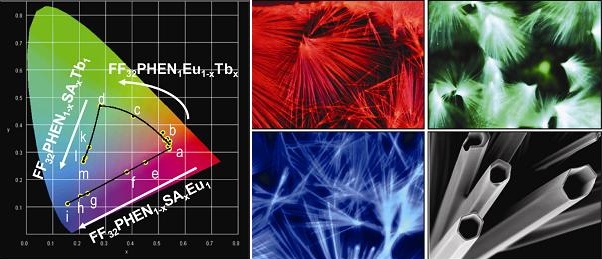KAIST Professor Park Chan-beom develops multi-color 'bio-nanotube'
성수 최 2009-05-06 View. 5,843New material seen to have applications in biosensor chips, next-generation display devices.
Study published in world-renowned materials journal, Advanced Materials.
A research team (state-designated laboratory for new biomaterials) led by Prof. Park Chan-beom at the new materials department of the Korea Advanced Institute of Science and Technology said on April 27 that it has developed a nanotube material that can generate diverse fluorescent colors, including red, green, and blue, by using self-assembly technology existing in nature.
The new material is expected to have applications as a biotechnology-based nanomaterial that can generate a wide-ranging color spectrum in various display devices.
The self-assembly technology refers to a phenomenon that creates a specific structure or pattern on its own through weak non-covalent binding interaction between a material's components.The technology is one of the most widely studied techniques in the world at present. The nature of chemical materials assembling themselves like Lego blocks to create a three-dimensional structure is the fundamental basis for a wide range of biological phenomena, and the technology is highly sought after as a key technique for developing nanomaterials.
Prof. Park and his team formed a nanotube structure one one-thousandth the size of a hair strand by allowing tens of thousands of very simple, two-amino acid peptides to self-assemble on their own. The team learned that in this process of self-assembly, photosensitization can be significantly magnified.
Notably, the team used a protein plaque known as "amyloid," which has been linked to Alzheimer's Disease, as the peptide in its study,allowing it to successfully develop a new functional nanomaterial by applying the phenomenon of degenerative nerve diseases.
The feat has drawn keen attention from the international science community.
The new auto-assembly fluorescent nanomaterial is expected to have applications in the areas of biosensors, biochips, cell carriers for various drugs, medical hydrogels, and next-generation display devices, and will help Korea strengthen its science and technology competitiveness in the nano- and bio-fusion sectors.

(Photo) The spectrum of fluorescent colors (left) generated by the KAIST research team and its bio-nanotube (right)
The team has been conducting the internationally acclaimed study since 2008 thanks to government funding, part of the "government-designated laboratory program" operated by the Ministry of Education, Science and Technology.
The study was published in the latest issue (April 27) of Advanced Material, a world-renowned material science journal. Experts say the study has made major contributions to the development of a new nanomaterial through the creative integration of nanotechnology and biotechnology.
In recognition of the work's importance and applicability, Advanced Material listed the study in its "Advanced in Advanced" category, an honor awarded to the top 10 percent of the best science papers.
Hello DD.com
Jung Yoon-ha
yhjeong at hellodd.com
?
[May 06, 2009]
- - - - - - -
Source - HelloDD.com

 Delete Article!
Delete Article!